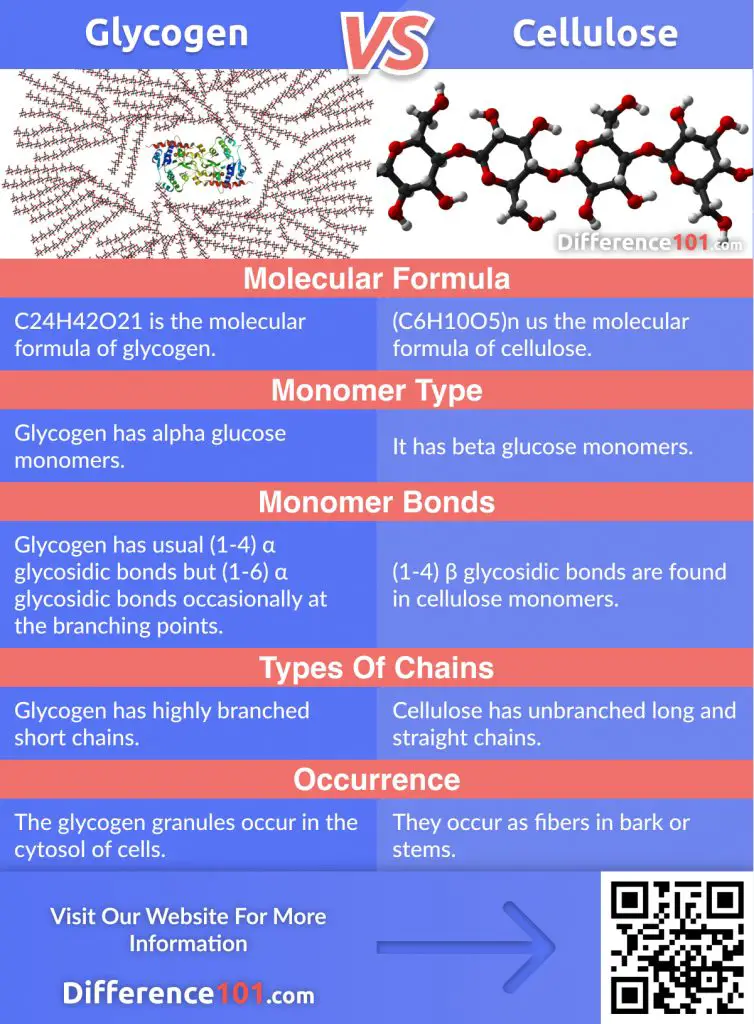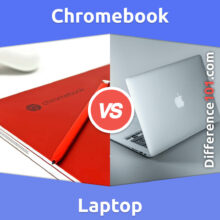Starch, glycogen, and cellulose are all forms of glucose. The starch vs. glycogen vs. cellulose difference can be seen in their presence in different types of plants. Starch is found in chlorophyll-rich areas of plants, glycogen is present in non-chlorophyll plants, and cellulose is found in the woody areas of the plants.
Let’s take a closer look at the differences between starch and glycogen and cellulose:
| Presence in plants | Starch is present in chlorophyll-rich areas of plants unlike glycogen and cellulose |
| Presence in the vertebrates | Cellulose is absent in vertebrates unlike starch and glycogen |
| Type of monomer | Cellulose has beta glucose monomers while the other two have alpha |
| Molecular mass | Starch has a variable molecular mass while the other two have fixed |
Table of Contents
What is Starch?
Starch is the stored form of glucose in plants. It is present in chlorophyll-rich areas of plants and some vertebrates. It has α glycosidic bonds and has a variable molecular mass.
What is Glycogen?
Glycogen is the stored form of glucose in animals. It is present in non-chlorophyll plants like fungi and all the vertebrates’ liver, skeletal muscles, and brain. It has α glycosidic bonds and has a fixed molecular mass.
What is Cellulose?
Cellulose is the stored form of glucose in plants. It is present in the cell wall and the woody areas of the plants but are absent in vertebrates. It has β glycosidic bonds and has a fixed molecular mass.
Pros and Cons
Starch Pros & Cons
Pros of Starch
- It helps in vital plant processes.
- Starch component amylose is soluble in water.
Cons of Starch
- Starch component amylopectin is insoluble in water.
- It increases the risk of diabetes.
Glycogen Pros & Cons
Pros of Glycogen
- Glycogen is the stored energy form for fungi and animal life processes.
- It is soluble in water.
Cons of Glycogen
- It might lead to bloating.
- Excess glycogen can lead to diarrhea.
Cellulose Pros & Cons
Pros of Cellulose
- It helps in forming cell walls in plants.
- It gives structural support to the cell.
Cons of Cellulose
- It is insoluble in water.
- It is indigestible for humans.
Starch vs. Cellulose vs. Glycogen Similarities Explained
- Starch, glycogen, and cellulose all are forms of glucose stored inside the living cells.
- The hydroxyl groups in all three polysaccharides are held together by hydrogen bonds with adjacent chains.
- All three of these polysaccharides have 1-4 glycosidic bonds in monomers.
5 Key Differences Between Cellulose vs. Glycogen vs. Starch That You Must Consider
The starch vs. cellulose vs. glycogen differences are listed here:
| Basis | Starch | Glycogen | Cellulose |
|---|---|---|---|
| Molecular Formula | (C6H10O5)n is the molecular formula of starch. | C24H42O21 is the molecular formula of glycogen. | (C6H10O5)n us the molecular formula of cellulose. |
| Monomer type | Starch has alpha glucose monomers. | Glycogen has alpha glucose monomers. | It has beta glucose monomers. |
| Monomer bonds | (1-4) α glycosidic bonds are found in amylose. (1-6) α glycosidic bonds are found in amylopectin. | Glycogen has usual (1-4) α glycosidic bonds but (1-6) α glycosidic bonds occasionally at the branching points. | (1-4) β glycosidic bonds are found in cellulose monomers. |
| Types of chains | Starch has unbranched and coiled chains in amylose; and branched and long chains in amylopectin. | Glycogen has highly branched short chains. | Cellulose has unbranched long and straight chains. |
| Occurrence | Starch occurs as a semi-crystalline kind of grain in amyloplasts. | The glycogen granules occur in the cytosol of cells. | They occur as fibers in bark or stems. |
Starch vs. Glycogen Comparison Chart

Glycogen vs. Cellulose Comparison Chart

Comparison Video
FAQ
Why do Starch Glycogen and Cellulose have Different Properties?
Starch, glycogen, and cellulose have different types of glucose bonds. Where starch and glycogen have α glycosidic bonds, cellulose has β glycosidic bonds. Also, starch and glycogen have fewer hydrogen bonds and cellulose has more hydrogen bonds. All this makes them display different properties.
What is the Main Structural Difference between Starch and Glycogen?
The query “What is the difference between starch and glycogen?” often takes us to the structural differences between the two. Starch has a linear, branched, and coiled structure while glycogen displays a branched-chain structure.
Why can Humans Digest Starch but Not Cellulose?
Starch can be digested since humans have the necessary enzymes to digest them while the enzyme required to digest cellulose is absent in them. (Ref. 1)
Can Humans Digest Cellulose?
No, humans cannot digest cellulose. It can be digested by a special enzyme called cellulase which is absent in humans.
What is the Function of Cellulose?
The function of cellulose is to give structural support to the cell.
What do Starch and Cellulose Have in Common?
Both starch and cellulose are stored forms of energy in plants with their structures linked by glucose monomers.
Why is Glycogen Better than Starch?
Glycogen is better than starch when comparing the glycogen vs. starch energy-releasing capacity. Glycogen doesn’t get crystallized like starch and thus, is readily available for release in case of an energy slump.
What is the Structural Difference Between Sugar and Starch?
Sugar has a simple molecular structure whereas starch has a complex molecular structure.
Can you Convert Cellulose to Starch?
Yes, cellulose can be converted to starch with the help of enzymatic reaction along with microbial fermentation. (Ref. 2)
Why is Cellulose More Stable than Starch?
Every alternate glucose molecule in cellulose is flipped over the other after a 180 degrees rotation. This firms up the cellulose fiber like corrugated sheets and thus, makes it more stable than starch.
The Final Words
Starch, glycogen, and cellulose are different forms of glucose but differ in their properties. Starch is present in chlorophyll-rich areas of plants whereas glycogen is found in non-chlorophyll plants like fungi. On the other hand, cellulose is found in the woody areas of the plants. While starch has a variable molecular mass, cellulose and glycogen have fixed molecular mass. Additional starch and glycogen can also be found in vertebrates while cellulose is not present in them.







